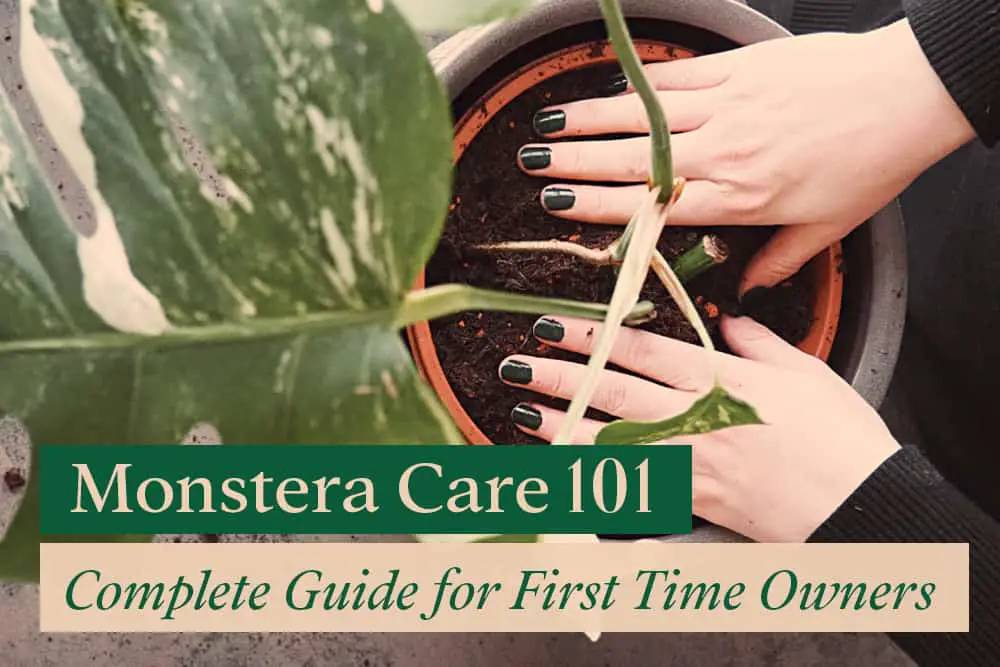
I am a proud owner of a few Monstera plants. And after a few months, I have become so attached to the Swiss Cheese plant that I wanted to share with you some tips for how to care for your Monstera.
In this in-depth guide, you will find information on the following topics:
- Buying Guide for your first Monstera
- The Basic Care of Monstera
- Common Problems with Monstera
- Advance Tips on Growing a Healthy and Happy Monstera
Let’s get started!
Buying Guide for Your First Monstera
Choosing the right Monstera plant is not an easy task. Various factors come into play when making your choice.
Do you want your plant to be big or small; do you want it to have variegation or plain leaves; do you want it to be a classic shape or an elegant shape.
Whatever your choice is, there is bound to be one Monstera variety that will suit all your needs.
Which Monstera Varieties Should You get?
First Time Adopter
The Monstera Deliciosa is an excellent plant for those who are just getting started. It’s not too big or too small, making it easy to maintain. This plant also has beautiful split leaves and is a classic shape. It will suit your needs as well as your taste!
Another great choice is Monstera Adansonii. It is a beautiful plant with an elegant shape and fenestrated leaves (holes), which are very popular among plant lovers today.
The Collectors
If you’re someone who collects plants, then you might want to buy the variegated Monstera.
Variegated Monstera has mutated leaves with lighter patches on them. These patches can be light green, yellow, or white.
Generally, variegated plants cost more than plain green Monstera due to its rarity.
Also, Variegated Monsteras are difficult to care for because they’re more likely to contract root rot; their patterns may be unstable and able to revert back to full green.
The two most popular variegated Monsteras are Monstera Albo Borsigiana and Monstera Thai Constellation.
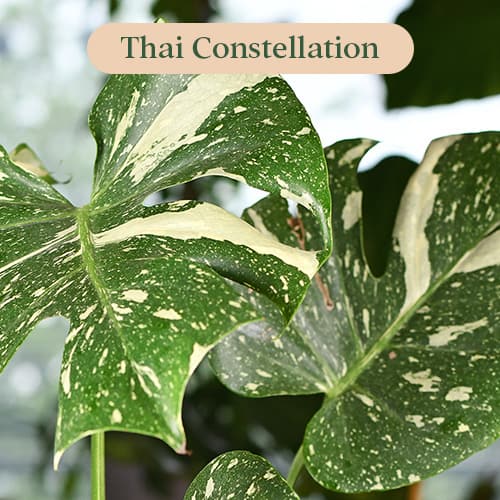
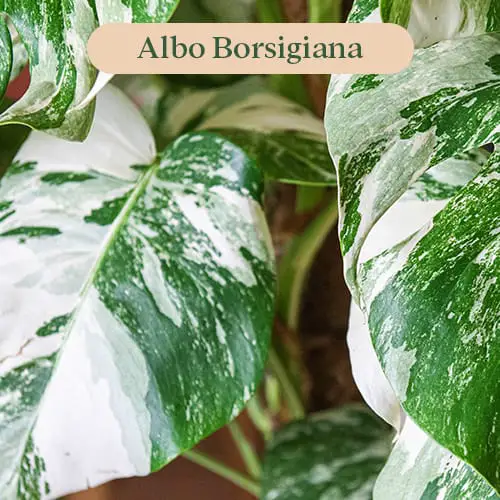
The One We All Dream About
Monstera Obliqua is arguably the rarest of the Monstera genus. It is claimed that the Monstera Obliqua has only been seen in the wild 17 times.

Many people confuse Monstera Obliqua with Monstera Adansonii. They both share the same characteristics but there are some key differences. One observation of Monstera Obliqua is that it seems more hole than leaf. The fenestrations are so extreme that on occasion the leaf looks like lace. And their leaves are much more delicate compared to Adansonii’s thick, sturdy leaves.
This is by far the most expensive type of Monstera. A single cutting can cost between $5,000 to $8,000 USD
How to Pick a Healthy Monstera
If you are looking to purchase a Monstera, it is important to be aware of the different signs that it may not be a healthy plant.
There are several things you should look for when trying to determine if the Monstera plant you are considering purchasing is healthy or not. Problems with foliage, and pests can all lead to poor health in your new plants.
Watch for Monstera leaves curl and browning
The first sign you should look for when considering a plant is the overall health of the leaves. If the leaves are curled, or if there is browning in any part of the plant, avoid purchasing this particular Monstera plant.
A Monstera with leaves curling and browning may have been exposed to a condition that includes an excessive amount of sunlight, or even water for too long–or too little water.
Check for Pests Infestation
Another indication that your newly purchased Monstera is not healthy is if there are any signs of pests on the leaves or stems. There are a variety of pests you may find on a Monstera, such as spider mites, mealy bugs, etc.
Pest Infestation on Monstera can be identified by the presence of small insects or small white “dust” on the leaves. They are very small signs that your plant may have been in contact with pests; check for dark spots or discoloration around the stems and leaves as well.
A Monstera with pests will need treatment to get rid of the problem, and this can take time and money that you don’t need to spend.
Basics of Monstera Care
The Swiss Cheese plant is one of the easiest plants to grow.
As a rule of thumb, Monstera prefers bright indirect sunlight or shade with high humidity. And they thrive when given moist, well-drained soil.
If it’s easier to use a checklist, here are some of the things to remember when dealing with Monstera:
Light Requirements
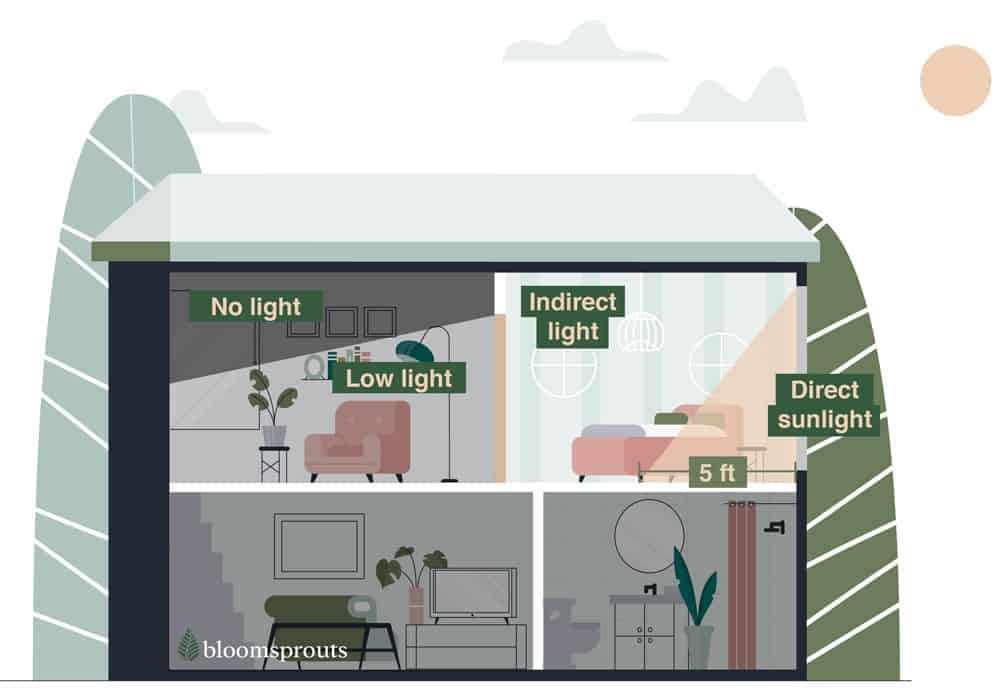
A Monstera plant will benefit from 10 to 12 hours of bright indirect sunlight as it needs the sun to produce energy. However, too much direct sunlight will damage the leaves and make it difficult for Monstera to produce energy to grow.
In the wild, this plant grows in tropical rainforests where sunlight is plentiful but there’s also lots of shade and shelter available.
Thus it is not picky about the kind of light it gets – Monstera will take whatever light you give it. It prefers to be on a bright windowsill but can do fine in a less-sunny room.
However, if it is placed in a really low light condition, you might need to provide it with grow lights for at least twelve hours a day for it to thrive.
Also Read: The Complete Guide for Monstera Light Requirements
Water Requirements
Monstera like moderate watering, this means they will need watering approximately once a week. You can test the moisture by poking your finger in the soil, if the first inch or two is dry the plant needs water.
Keep in mind that Monstera plants are sensitive to overwatering and need good drainage, so make sure to use a pot with holes and place them on an appropriate surface (e.g., a saucer) that collects water runoff from the bottom of the pot.
The best way to water Monstera is to water the plant thoroughly and deeply, then allow the excess water to drain from the pot.
The drainage hole should be checked for debris every month or so to ensure that it is not plugged by mineral deposits or other debris. Be sure that in clay pots, there are cracks in the bottom of the pots for aeration.
Humidity Level
Monstera prefers medium to high humidity levels (60% – 80%). It will become stressed when the humidity falls below 50%. This is why one of the most common causes for slow growth in Monstera can be caused by low humidity.
You can determine humidity level by using a hygrometer. Remember, the reading may be different from one room to another as the humidity levels may be different. For example, the humidity level in the bathroom can be more than that in the house.
A quick-fix for dry air is misting, but it doesn’t do the job well enough. If you’re looking for long-term humidity relief, you need a humidifier or pebble tray to raise the humidity around the plants.
Alternatively, you can grow them in an environment with higher humidity, such as a bathroom, a greenhouse or conservatory.
Temperature
While the plant is native to tropical rainforests, it has adapted well to life in more temperate climates and should be considered an indoor-only houseplant if you live in a colder region where it freezes during winter.
The Monstera plant thrives best when it is situated in a temperature range of 60°F to 80°F (16°C to 27°C). Nevertheless, if the temperature drops below 50°F (10°C) for more than a few days in a row, growth will cease.
Soil Mixture
If you notice that the Monstera you’ve bought is not growing well, sometimes it might be because of the soil. See if the soil is too dense, too wet, or lacks nutrients.
Monsteras prosper on a well-drained and aerated soil. This means the soil should be porous and have room for air to circulate. For this type of soil, mix a combination of Orchid bark chips, coconut coir, perlite, activated charcoal, and worm casting together.
Fill the pot with the soil mix and plant your Monstera so that the top of the roots are just barely below the surface.
Check out my Soil Mix Guide for Monstera to find out how to customize your own soil mixture by using the above ingredients.
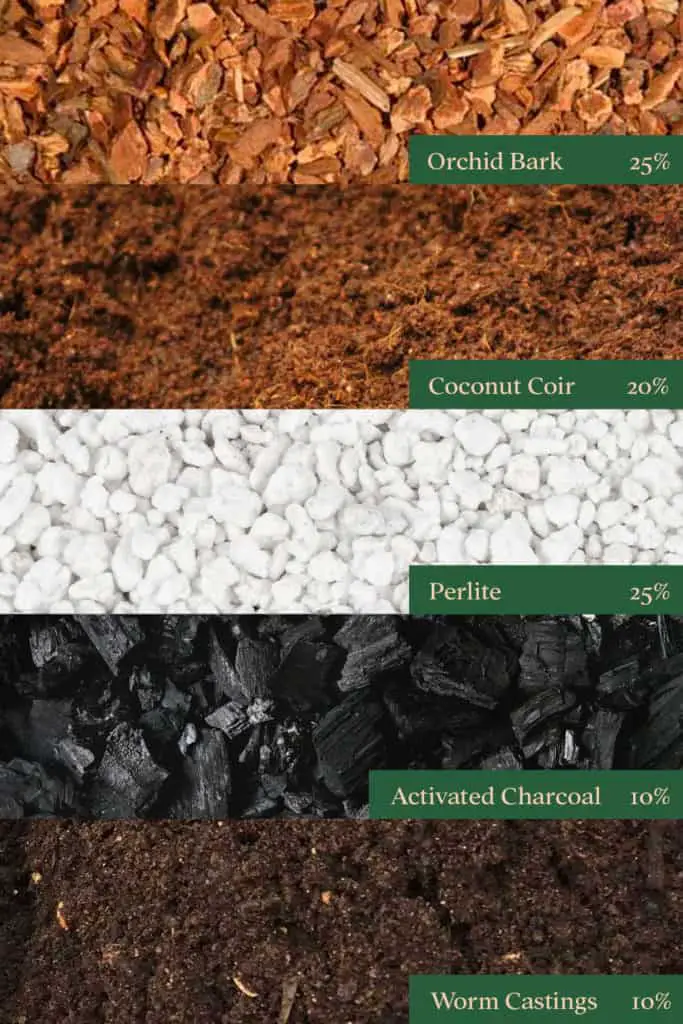
Fertilizing
Many people think that when caring for Monsteras, fertilizing is just unnecessary. However, it can really make a difference in how healthy your plant is and if it has enough energy to grow and flourish.
There are signs that your Monstera is not getting enough nutrients, such as leaves will start to be yellow, wilted, or have leggy growth. Another sign is that your Monstera will experience slow growth and seeing less fenestrations (splits and holes).
Personally, I feed my Monstera once a month during the growing season (from late March until mid-November) using 20-20-20 liquid fertilizer. Placing about half a teaspoon of liquid fertilizer in about a gallon of water is a good way to do it.
During the winter, many people choose not to fertilize their plants. The reason for this is because it is harder for the plant to take in nutrients when it’s cold out. Fertilizing a Monstera during the winter can actually cause more harm than good.
Also Read: Fertilizing Guide for Monstera – Is it Necessary?
Common Problems with Monstera
Although Monstera is easy to care, there are a few problems that you may encounter with this indoor plant. I will be going over some of the most common problems and how you can fix them:
Leaves turns yellow or brown
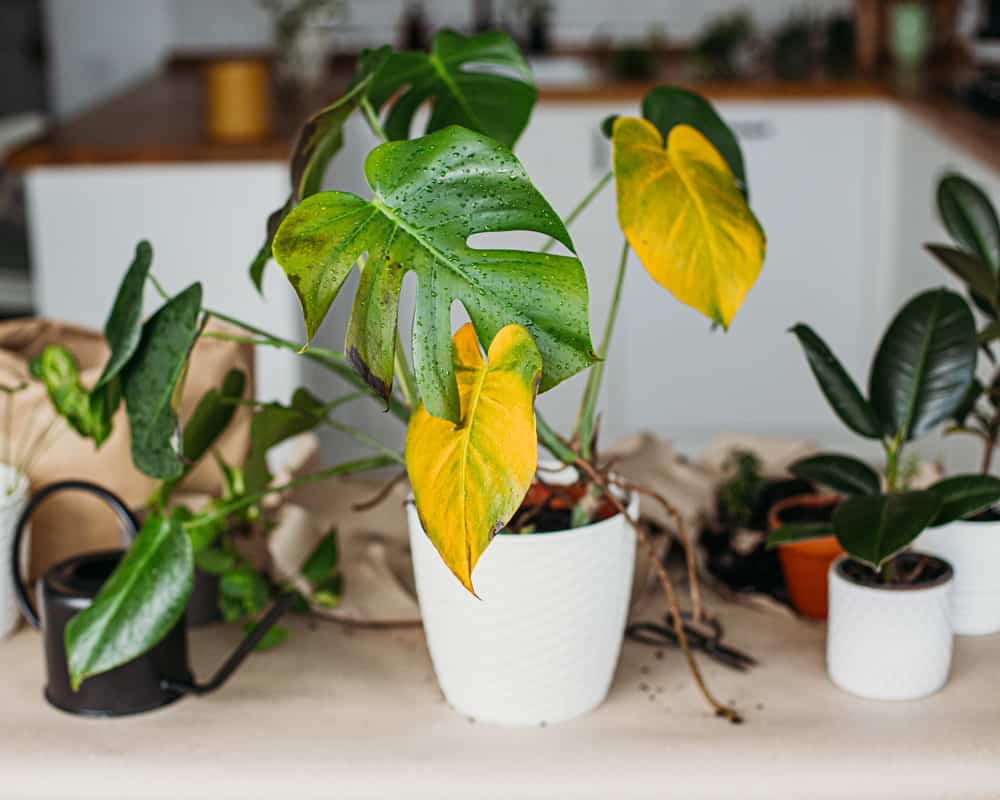
Monstera leaves turning yellow or brown usually signals a problem caused by improper watering, light, feeding, or environmental changes. It can also be a symptom of pests like mealybugs, thrips or spider mites.
To determine the exact cause for the change in color, you will need to examine the Monstera’s soil and root.
If the leaves are turning yellow or brown because of improper water, it ‘s likely that your Monstera is being overwatered or underwatered. Make sure the soil drains properly and let it dry between waterings.
Be aware that overwatering may lead to root rot. This is a condition where anaerobic bacteria eat away at the roots and can kill the plant.
If the problem is pest infestation, check to see what pests are damaging it and treat them accordingly. Many of them drain the plant’s sap or gnaw at its root.
Also read other reasons and treatment for why Monstera leaves turn yellow or brown.
Leaves drooping
A droopy Monstera plant is not something to be taken lightly. This state is a sign that your plant needs serious attention. Generally, this is a symptom under watering. A quick watering is something that will easily solve the problem.
Typically, here are some reasons why the plant droops:
- Underwatering: A Monstera leaf droops when it is thirsty. Water your plant immediately to avoid wilting.
- Temperature stress: Being a tropical plant, Monstera plants are often damaged by the effects of sudden extreme change intemperature. When temperatures exceed 80°F (27°C) or drop below 50°F (10°C), there is a possibility that the plant will be too stressed and droopy.
- Root rot: Damage on the root disrupts the water and nutrient supply. Thus causing the leaves to droop.
- Transplant shock: Repotting to a large container can cause the Monstera plants leaves to droop as well. But don’t worry, the plant will bounce back quickly when the root system is healthy enough.
- Pest: Some pests can also cause the drooping of the leaves. This is especially common with spider mites and scale insects.
Root rot
The most serious and fatal problem that often occurs with Monstera plants is root rot. Root rot is a term that refers to the decay of the plant’s root tissue. Generally root rot is caused by over-watering.
Root rot can quickly kill your Monstera so make sure to check for this disease before doing any care or maintenance.
Here’s how to fix roots rot in Monstera:
- Assess the damage: Check for black discoloration on the roots? Also check if the rot also affects the stems.
- Remove all affected parts: Knife out and remove all parts affected by root rot. Make sure only the white healthy part of the roots are left.
- Repot: Place the plant in a clean pot with new well-drained and aerated soil mixture.
- Wait and pray: Be patient and wait for the plant’s health to improve. Make sure you place and treat it with proper lighting, humidity and water.
Pest on Monstera
There are a number of bugs that can infest your Monstera, such as mealy bugs, thrips, scale, fungus gnats and spider mites.
Cleaning your Monstera leaves on a regular basis will help you to identify early signs of pests so that you can treat them before they become a problem. Also, check for signs of infestation if you think your plant may be sick or is not growing the same as it once did
Here’s how I usually eradicate bugs on Monstera:
- Scale: usually found on the stems, they are oval in shape, white in colour and very hard to see. Remove them with a cotton swab dipped in alcohol or by rubbing them off with your fingernail.
- Mealybugs: tend to be found underside of the leaves. They look like small cotton balls stuck to the leaf surface. Similarly, use a Q-tip with alcohol or scrape them off the leaves.
- Thrips: are hard to spot and have a very short life cycle. Keep an eye out for small black spots on the leaves.
- Fungus gnats: you will find these pests flying around in your Monstera’s potting soil. To get rid of them, you can spray them with a mixture of water and 3% hydrogen peroxide or add more horticultural charcoal to sterilize the topsoil.
It is also best to always keep new plants isolated for at least one month to ensure that the pests do not spread to your existing plant collections!
Also Read: Why Neem Oil is best to Repel Bugs and Pests
Fenestration problem
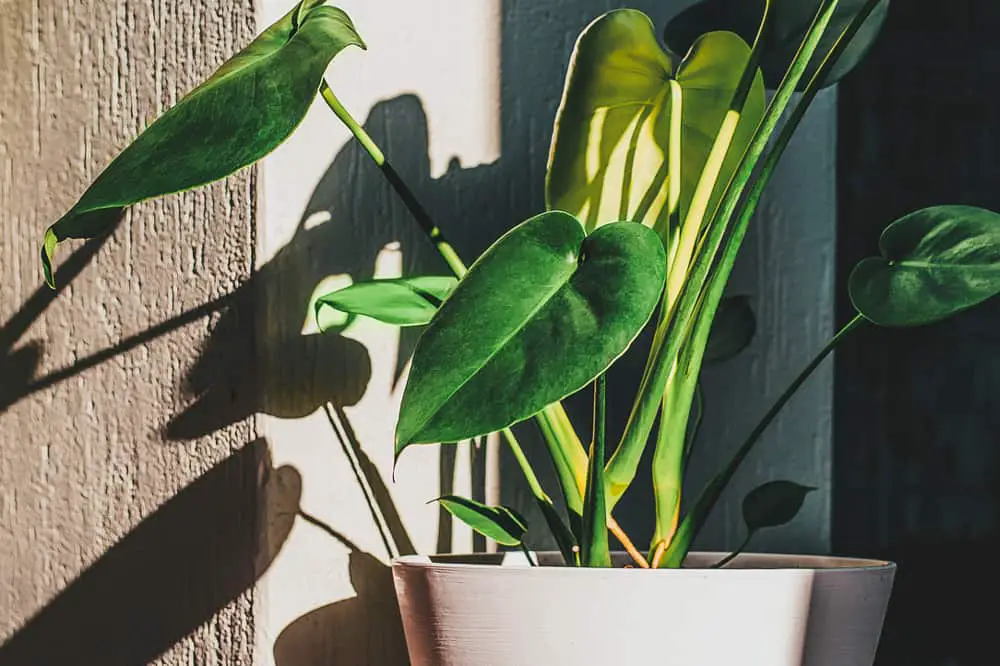
Well, you might be wondering why some monstera plant leaves have splits and holes (also known as fenestration) while others do not.
The answer is simple:
- Your Monstera is too young: A Swiss Cheese Plant is a slow grower that can take anywhere from 2-3 years to develop its characteristic holes and splits.
- Improper care: A Swiss Cheese Plant that is not getting enough sunlight, watering, and fertilizers would not develop fenestration.
I recommend reading this article on how to encourage fenestration on your mature Monstera and some interesting facts about the plant.
Tips for Growing a Monstera
Growing a Monstera plant is not always easy. Yet, with the right care and patience, it will grow lushly. There are many things to consider apart from how much sunlight it needs, how often you need to water it, which fertilizer to use.
Let’s dive deeper into tips you should know about growing monstera plants:
How often does Monstera Grow New leaves
In general, Monstera can grow new leaves every 4 to 6 weeks. However, the frequency of leaf growth depends on many factors such as temperature, light exposure, potting mix, and humidity.
If you happen to notice that your Monstera is growing new leaves, make sure to let it unfurl naturally. When you interfere with the process, it may not develop properly and may even stunt the growth.
How Big Can a Monstera Get?
Typically, Monstera Deliciosa can grow as high as 10 to 15 feet tall when grown indoors with the help of a Moss Pole. A mature monstera leaf can measure up to 20 inch across.
Monstera Adansonii on the other hand tends to grow faster and as long as you provide vertical support, it can grow as high as 15 feet tall as well.
Growing a Monstera during the Winter
Monstera plants are hardy because they can withstand the low light condition that comes with Winter. Although, it will wither if you leave them outside and the temperatures drop extremely below 15°C/60°F.
Lower sunlight will also impact the energy-producing process of photosynthesis. This will slow down your Monstera growth.
Here are some tips for taking care of a Monstera plant in Winter:
- Less watering: Ideally, you should water your plant every two to four weeks. Make sure you have good drainage and the top two inches of soil to dry out to avoid overwatering.
- Less fertilizer: You may want to reduce or stop adding fertilizer in Winter. If you do add fertilizer, you should dilute your chosen fertilizer by half its strength.
Pruning a Monstera
One of the most important routine practices to keep your Monstera healthy and happy is pruning them regularly. By pruning your plant, you will promote new growth and encourage the plant to grow.
I tend to prune my monstera regularly, at least once or twice every month, depending on how fast the plant grows. Monstera likes to be pruned, and spring is the best time to do it.
Depending on your goal, you may want to prune each Monstera differently:
- If you want your Monstera to grow taller, then you may want to prune at the top of the plant. You should also introduce a pole for it to climb up.
- If you want to control the size of the Monstera plant, you can safely trim the plant down to size.
- But, if you want to propagate your Monstera, make sure you prune a few inches below a leaf node. Nodes are the sections on a stem where new leaves, stems, and aerial roots originate.
Propagating Monstera in Water
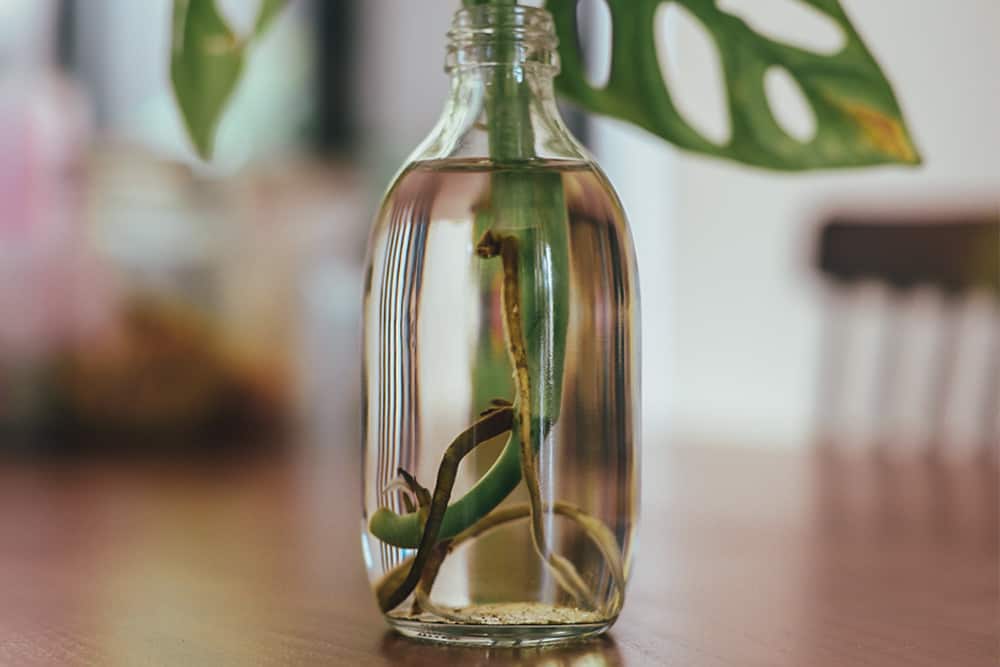
After pruning your Monstera, don’t throw away the cuttings! Instead, put them in water and watch roots grow! There are many ways to propagate the Monstera, but this one is both easy and fun.
When propagating you can either take small cuttings of just one or two leaves, or you can cut one full cutting that has 4 to 5 leaves and nodes on one vine. It is also ideal if some aerial roots are on your cutting.
Place the cuttings on a vase or jar that you have filled with rainwater or distilled water, and place the vase in bright, indirect sunlight.
After 2 to 3 weeks, you should see roots developing. Keep the cuttings in the water until they have developed about 10 to 15 new roots (each about 2 – 3 cm long) before planting them in the soil. This may take a few weeks, but it is very well worth the wait.
Also read: Can You Propagate Monstera Without Node?
Repotting a Monstera
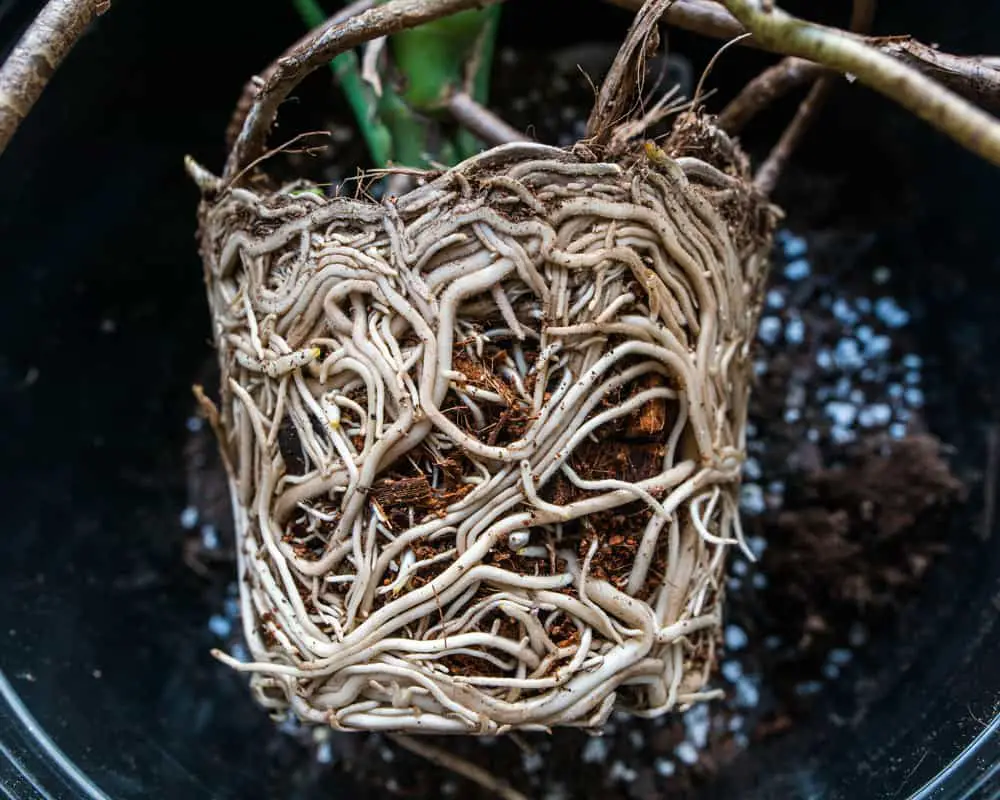
When you start seeing small white roots coming out of the pot drainage, it means your plant is getting root-bound and it’s time for a repot. I tend to do mine once every two or three years.
Monstera roots should be able to grow in all directions. But if they’re in a small container, the roots will grow around the inner edge of the pot instead. Eventually, those roots will form a tight mass that prevents moisture absorption. If not corrected, this can eventually lead to root rot.
When repoting consider buying at least one size larger pot than the previous container. Also make sure to buy pot with lots of drainage.
Also Read: Choosing the Best Pot for Monstera
